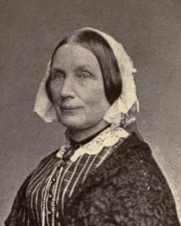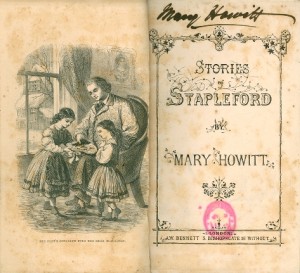
Annie, born January 15, 1824, was the daughter and eldest child of the prolific writing team of William and Mary Howitt.
The couple translated German, French, and Scandinavian literature and wrote fiction, poetry, biographies, travel books, and works for children.
Young Annie grew up in a special household indeed. "Let us," Mary once wrote her sister, "accustom our children to elegant objects as far as our means permit."
William Wordsworth sent Annie copies of his children's poems for her approval when she -was only seven years old.
From 1840 until 1843 the family lived abroad in Germany because the Howitts considered Pestalozzi-inspired German educational methods superior to English models.
The precocious 15-year-old Annie illustrated Hymns and Fireside Verses (1839), one of her parents' most successful books.
Her adult friends included Dante Gabriel and Christina Rossetti, John Ruskin, George Eliot, Charles Dickens, and other prominent Victorian artistic and literary figures.'
In her early twenties Annie became involved with the influential group known as the Pre-Raphaelites. The Pre-Raphaelite "Brotherhood," founded by Dante Gabriel Rossetti, John Millais, and William Holman Hunt, rejected the formal and unimaginative style of the Royal Academy school of painting, where a common practice consisted of copying old masters.
In Hastings Barbara Leigh-Smith also met Anna Howitt and her children; Eliza Fox Bridell; Gertrude Jekyll; Marianne North, whose father was one of the two Hastings' MPs; Miss Bayley of 2 Holloway Place; and Ann Samworth and her children, who lived at Brooklands Cottage, Holloway place, Old London roadIn 1850 Bessie Parkes introduced Barbara to her cousin, the first woman physician, Dr. Elizabeth Blackwell. However, Barbara's cousin Florence Nightingale snubbed her Uncle Ben's illegitimate offspring.As young women of 21 and 23, Bessie and Barbara were, most unusually, allowed to go unchaperoned on a walking tour of Belgium, Germany, Switzerland, Austria, visiting Mary Howitt in Munich.
The three discussed women's inferior status and wanted to change it.
But men held all political power and would fight to preserve the system which served their interests so well.
The two did, however, indulge in a little personal liberation.
Female costume at the time was uncomfortable, impractical and restrictive.
They abandoned their corsets and shortened their skirts, prompting Barbara to pen the lines:
Oh! Isn't it jolly
To cast away folly
And cut all one's clothes a peg shorter
(A good many pegs)
And rejoice in one's legs
Like a free-minded Albion's daughter.
March 12, 2012, by H Cotterill
“Will you come into my parlour?” said the Spider to the Fly,
‘Tis the prettiest little parlour that ever you did spy;
‘Tis the prettiest little parlour that ever you did spy;
So begins the famous children’s poem, ‘The Spider and the Fly’. This is just one of the many poems and stories written by the celebrated Victorian author Mary Howitt whose collection of family correspondence is held in Manuscripts and Special Collections.
The Howitts certainly encountered their fair share of ‘spiders’, with one such encounter leading to a 19th century case of identity theft. In a letter to her sister Anna, Mary Howitt describes how she and her husband William had befriended a young couple only to discover that the husband was writing begging letters in Mary’s name. He managed to collect several hundred pounds before the fraud was discovered and he disappeared.
The Howitts certainly encountered their fair share of ‘spiders’, with one such encounter leading to a 19th century case of identity theft. In a letter to her sister Anna, Mary Howitt describes how she and her husband William had befriended a young couple only to discover that the husband was writing begging letters in Mary’s name. He managed to collect several hundred pounds before the fraud was discovered and he disappeared.
The Howitt correspondence collection contains many such stories and personal anecdotes and offers a fascinating insight into the lives of a middle class family in the nineteenth century. Correspondents include Mary Howitt, her sisters Anna Harrison and Emma Alderson and Anna’s daughter Anna Mary. With the majority of the letters being sent to and from women the correspondence inevitably touches on domestic issues, including the raising of children, as well as on the role of women themselves. There are a fascinating series of letters written by Mary’s sister Emma Alderson. Emma emigrated to America with her husband in 1842, settling in Cincinatti Ohio. Emma wrote regularly to her family in England and her letters offer an insight into life in America in the decades immediately prior to the American Civil War. Other key themes in the letters include spiritualism and religion, health and horticulture. The letters also provide evidence about the literary careers of Mary and her husband William who also worked as a writer.
The image above shows an example of a crossed letter from the collection. Until the introduction of the Penny Post in 1840 the cost of posting was affected by the number of sheets of paper used. Using two sheets of paper doubled the cost. To avoid this people ‘crossed’ their letters, filling a sheet of paper and then turning the page at right angles to continue writing.
The catalogue to the Howitt correspondence collection is available to view online. The collection contains just over 1200 letters. Of these 1200 approximately 400 have been catalogued in full. The remaining 800 require further cataloguing work, to provide a summary of the letters’ contents, but are fully searchable by correspondent and
Other material relating to the Howitts can be found elsewhere in the archive. The Briggs collection of Literary Papers and Correspondence from the Sutton Family contains a series of letters written by Mary and William Howitt and their daughter Margaret to William and Eliza Oldham nee Sutton. The Briggs collection is fully catalogued and the catalogue can be viewedonline. There is also a collection of books written by Mary and William Howitt held in Special Collections. These can be searched for using the library catalogue athttp://aleph.nottingham.ac.uk/F
All of the manuscripts and books mentioned above are available to view in the Manuscripts and Special collections reading room at King’s Meadow Campus.T
There is a lot written about Anna Maria Howitt.also in connection with the Leigh -Smith and Samworth girls.
The Howitts certainly encountered their fair share of ‘spiders’, with one such encounter leading to a 19th century case of identity theft. In a letter to her sister Anna, Mary Howitt describes how she and her husband William had befriended a young couple only to discover that the husband was writing begging letters in Mary’s name. He managed to collect several hundred pounds before the fraud was discovered and he disappeared.
The Howitts certainly encountered their fair share of ‘spiders’, with one such encounter leading to a 19th century case of identity theft. In a letter to her sister Anna, Mary Howitt describes how she and her husband William had befriended a young couple only to discover that the husband was writing begging letters in Mary’s name. He managed to collect several hundred pounds before the fraud was discovered and he disappeared.
The Howitt correspondence collection contains many such stories and personal anecdotes and offers a fascinating insight into the lives of a middle class family in the nineteenth century. Correspondents include Mary Howitt, her sisters Anna Harrison and Emma Alderson and Anna’s daughter Anna Mary. With the majority of the letters being sent to and from women the correspondence inevitably touches on domestic issues, including the raising of children, as well as on the role of women themselves. There are a fascinating series of letters written by Mary’s sister Emma Alderson. Emma emigrated to America with her husband in 1842, settling in Cincinatti Ohio. Emma wrote regularly to her family in England and her letters offer an insight into life in America in the decades immediately prior to the American Civil War. Other key themes in the letters include spiritualism and religion, health and horticulture. The letters also provide evidence about the literary careers of Mary and her husband William who also worked as a writer.
The image above shows an example of a crossed letter from the collection. Until the introduction of the Penny Post in 1840 the cost of posting was affected by the number of sheets of paper used. Using two sheets of paper doubled the cost. To avoid this people ‘crossed’ their letters, filling a sheet of paper and then turning the page at right angles to continue writing.
The catalogue to the Howitt correspondence collection is available to view online. The collection contains just over 1200 letters. Of these 1200 approximately 400 have been catalogued in full. The remaining 800 require further cataloguing work, to provide a summary of the letters’ contents, but are fully searchable by correspondent and
The catalogue to the Howitt correspondence collection is available to view online. The collection contains just over 1200 letters. Of these 1200 approximately 400 have been catalogued in full. The remaining 800 require further cataloguing work, to provide a summary of the letters’ contents, but are fully searchable by correspondent and date. The collection was purchased with help from the Victoria and Albert Museum.

Other material relating to the Howitts can be found elsewhere in the archive. The Briggs collection of Literary Papers and Correspondence from the Sutton Family contains a series of letters written by Mary and William Howitt and their daughter Margaret to William and Eliza Oldham nee Sutton. The Briggs collection is fully catalogued and the catalogue can be viewedonline. There is also a collection of books written by Mary and William Howitt held in Special Collections. These can be searched for using the library catalogue athttp://aleph.nottingham.ac.uk/F
All of the manuscripts and books mentioned above are available to view in the Manuscripts and Special collections reading room at King’s Meadow Campus.T
There is a lot written about Anna Maria Howitt.also in connection with the Leigh -Smith and Samworth girls.
No comments:
Post a Comment